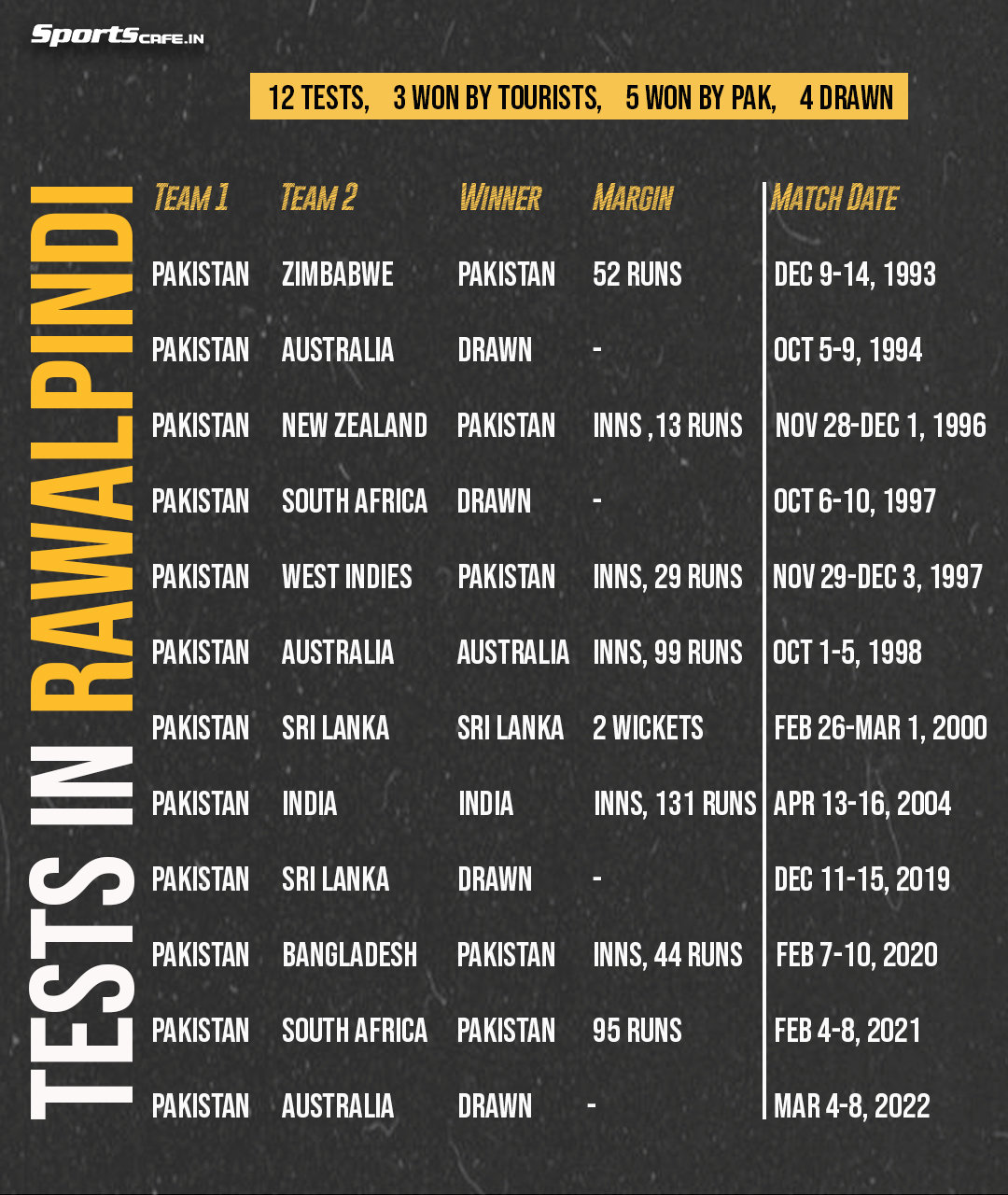Pakistan are digging their own grave by producing lifeless Rawalpindi pitches
Due to Rawalpindi’s unpleasant pitch and conditions, PCB has received severe criticism throughout their historic fixture against England. The unresponsive surface frustrated viewers all across the world, and PCB is needlessly bringing trouble to its doors in an attempt to invite major nations.

Despite having a reputation of being the most unpredictable full-member cricket nation, Pakistan’s ambitions to play the World Test Championship (WTC) final seemed well and truly on the cards ahead of their historic tie against England in Rawalpindi. With a point percentage of 51.85, they might be currently fifth on the table, behind Australia (70%), South Africa (60%), Sri Lanka (53.33%), and India (52.08%), but considering their five remaining Test matches of the cycle against England and New Zealand are all at home, it wasn’t really a mountain to climb. A small hillock maybe at best. In fact, with five victories out of five, they could shoot up their percentage to 69 and potentially finish, in all likelihood, at the top.
Last Thursday, almost every ardent cricket fan was looking forward to how things were going to unfold in Rawalpindi, where Pakistan are having the first of their five assignments. The worldwide interest had increased even more after England, despite being affected by an illness a day before, agreed with the Pakistan Cricket Board (PCB) to play at the scheduled time. But what followed after was nothing but disappointment, courtesy of a lifeless pitch, which Naseer Hussain described as ‘an absolute road’ on air.
The Rawalpindi Test gave no indication that either of the sides could kill off their opponents. It was a batting paradise, and England, highly lauded for their ‘Bazball’ approach, broke a 112-year-old record by piling up 506/4 on Day 1 of the Test, that too in 75 overs before bad light forced early stumps. To provide context about how dead the pitch was, this was the first time in Test cricket that all four openers have scored hundreds in the first innings of a match. The above statement has been made with all due respect to Zak Crawley, Ben Duckett, Abdullah Shafique, and Imam-ul-Haq, with the intention to highlight how badly the pitch was curated for the bowlers.
Joe Root decides to bat left-handed 😳#PAKvENG | #UKSePK pic.twitter.com/GOvnkof54B
— Pakistan Cricket (@TheRealPCB) December 4, 2022
“The objective of a Test pitch shall be to allow all the individual skills of the game to be demonstrated by the players at various stages of the match,” ICC’s Pitch and Outfield Monitoring Process, which has been in charge since 2018, explained in a statement. “ If anything, the balance of the contest between bat and ball in a Test match should slightly favour the bowling team and a pitch should be expected to deteriorate as the match progresses, and as a consequence, the bounce could become more inconsistent, and the ball could deviate more (seam and spin) off the wearing surface.”
To say the least, Rawalpindi produced a disastrous pitch to welcome England to Pakistan after 17 years. But what made matters worse was they do not seem to learn from their own mistakes.
There are various ways of taking wickets at Rawalpindi, but they all come with bans of 3-10 years.
— Iceland Cricket (@icelandcricket) December 2, 2022
Earlier in 2022, during Australia’s first visit to Pakistan after 24 years, Rawalpindi pitch curators had the opportunity to install a lively track in order to attract more viewers. But there, they disappointed as well by making the same flat surface, allowing the bowlers to take just 14 wickets for 1,187 runs across five days before the contest eventually ended in a lame draw. As a consequence, the ICC rated the pitch ‘below average’ for Test cricket and subsequently gave the venue one demerit point.
“We need to beat Australia, and we need to prepare our strategy accordingly, and the strategy is for low-bouncy tracks where reverse (swing) can happen, where lbw and bowled will be in play, where our spinners can show their performance, and where the batters, who have grown up on low-bounce pitches, can utilize that advantage," PCB Chairman Ramiz Raja had explained last time indicating the pitch was purposely prepared such, although he did admit the contest ‘wasn't a good advertisement’ for cricket. However, this time against England, Raja has no excuses in his bag for the outcome. In fact, during Day 2 of the match, he had openly slammed the curators, exclaiming: “It is embarrassing for us (Pakistan), especially when you have a cricketer as chairman.”
PCB Chairman reflects on the Rawalpindi Test and reiterates his plans on pitches for domestic and international matches in the country#PAKvAUS l #BoysReadyHain pic.twitter.com/OuD7wDvJw1
— Pakistan Cricket (@TheRealPCB) March 9, 2022
Safe to say, Pakistan are letting everyone down by installing dull pitches on historic occasions. They have lately started to resume cricket in their country since the Lahore terror attack in 2009, but such welcomes won’t allow the other nations to accept their invitations in the days to come.
Interestingly, before the Australia fixtures, Rawalpindi had not been making such pitches since cricket returned to the country in 2019. The stadium had hosted matches against all three countries – Sri Lanka, Bangladesh, and South Africa – which went to play there before Australia and England in that period. In those fixtures, there was no effort to nullify the bowlers, leading spectators to enjoy eventful days. In fact, out of those three games, Pakistan ended up winning twice, against Bangladesh and South Africa. And who knows the fixture against Sri Lanka would have had a result as well, had rain not relentlessly interrupted across all five days.

 © SportsCafe Graphic Team.
© SportsCafe Graphic Team.So why was this unnecessarily surprising strategy against England and Australia adopted when the results had been in their favour? Even Ramiz Raja does not know how to answer this paramount question. Before these two matches, eight out of 11 Tests in Rawalpindi had produced results, of which five ended in triumphs for the hosts.
The board doesn't direct how pitches are made. I've left this to the think tank. We look at our strengths and then the pitch and then make selections. This will improve by next season. Unfortunately, we'll see the same kinds of pitches for the New Zealand series
Not to forget, Pakistan, for the first time since 2003, named four debutants in the recent Rawalpindi Test. Three of them – Haris Rauf, Mohammad Ali, and Zahid Mahmood – were designated bowlers. Now only time will tell whether Pakistan will get someone who can match the statures of Wasim Akram, Waqar Younis, Shoaib Akhtar, or at least, Wahab Riaz but it can be easily said that such a flat Rawalpindi track was not motivational for the trio to become successful in all conditions in the future.
Along with the debutants, 19-year-old Naseem Shah, widely regarded as one of the next big things in Pakistan cricket, was playing in Rawalpindi as well to improve his Test numbers. However, playing on such surfaces certainly won’t help to boost his confidence, and who knows whether it will make an impact in the long run as well.
No wonder everyone was thrilled when cricket returned to Pakistan after 10 years with the three-match ODI series against Sri Lanka in 2019. From there on, major nations have been slowly inching their way to play there. However, if they continue to produce tracks in the same lackadaisical manner despite receiving warnings from the ICC twice this year, the excitement among others to travel to the subcontinental giant’s backyard might disappear very soon.

Comments
Sign up or log in to your account to leave comments and reactions
0 Comments